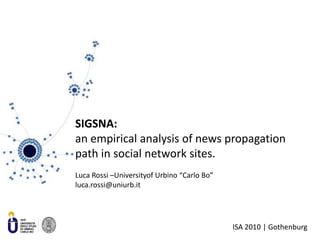Gothenburg
- 1. SIGSNA:an empirical analysis of news propagationpath in social network sites.Luca Rossi –Universityof Urbino “Carlo Bo”luca.rossi@uniurb.it
- 2. Global phaenomenon, expressing cultural peculiarities.
- 6. LocalGlobalUserProb. of expositionAvg. audienceTimeDelay of receptionAvg. lifetimeHowwe can observepropagation?
- 7. dataAll public entries(post and relatedcomments)(Sept. 6–Sept. 19 2009)≃ 10.500.000 posts   ≃ 500.000 likes.   ≃ 450.000 users.  ≃ 15.000.000 di archi (subs).
- 8. case study: a propagationMike Bongiorno (famousItalian TV host) died on Sept. 8 2010.The newsappears in Friendfeed at 01.57 PM:- First entry 130 comments- Allentries585 comments
- 10. Using timestamps and network of followers we have been able to track the propagation paths identifying major hubs.
- 11. Short propagationchainsLong propagationchainsNo propagation
- 15. Explicit news sharing is followed by chatting and discussion. This kind of activity contribute to news propagation“Bye Mike! We’re missingyou!Bye granpa Mike!Mike, you’ve been a milestoneofour TV”- Explicit news propagation.- Implicit news propagation.- Mourningritualof the networked public.
- 16. First entry has the highest informative functionMost commented entry is a long and articulated discussion
- 17. Mass media system 2.0 ?FriendfeedMajor Italian Newspapers(Il Corrieredella Sera, La Repubblica)
- 18. Mass media system 2.0 ?When the news hit the Friendfeed network only SkyTg24 wasbroadcastingit. The selection code is up to the end user and hedecideswhenever a specific information is informative.
- 19. Mass media system 2.0 ?Is the evolutionof news/chat thatwehavedetectedsimilartocouple news/reportage?
- 20. More info, papers and data:http://larica.uniurb.it/sigsnaSIGSNA is a joint research project with the department of Computer Science of the University of Bologna (Dr. MatteoMagnani) and it is partially founded by Telecom Italia.




















